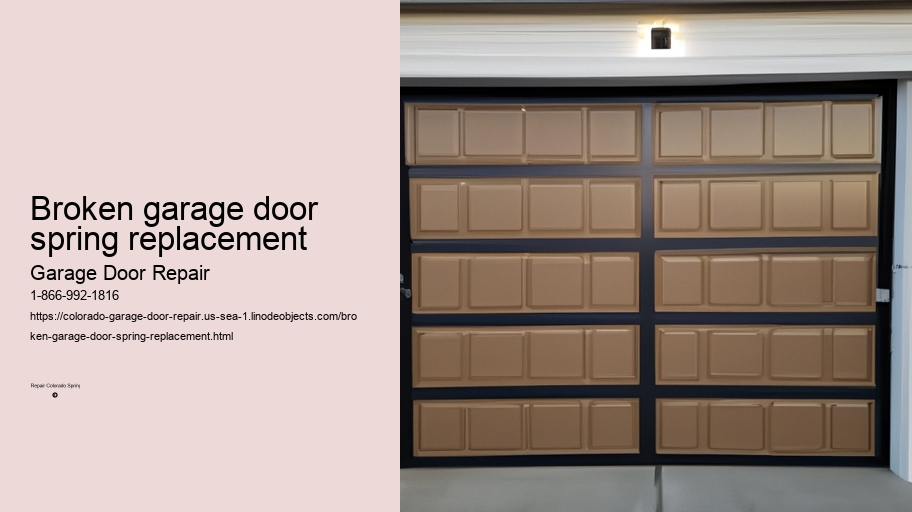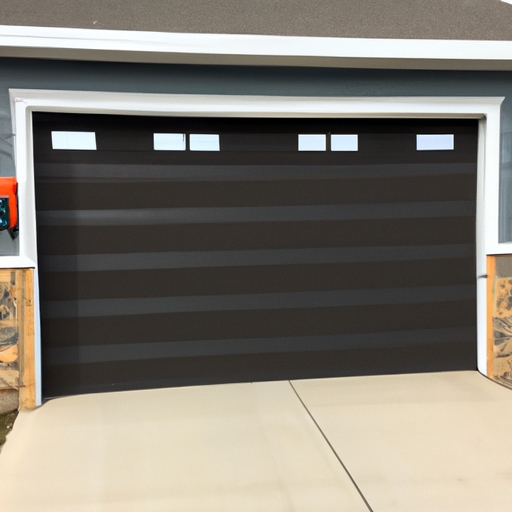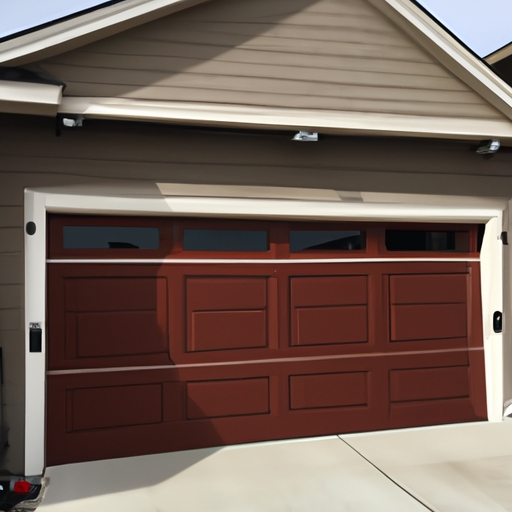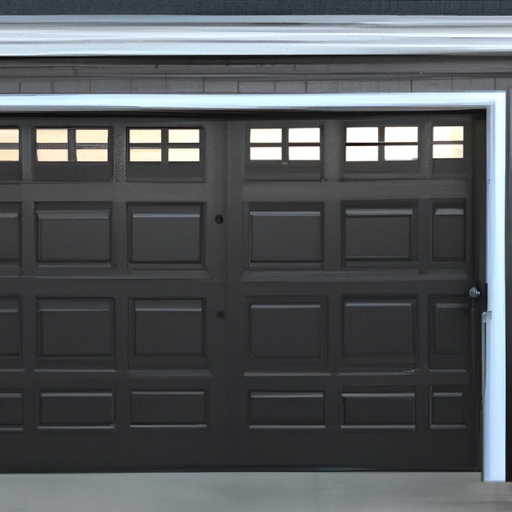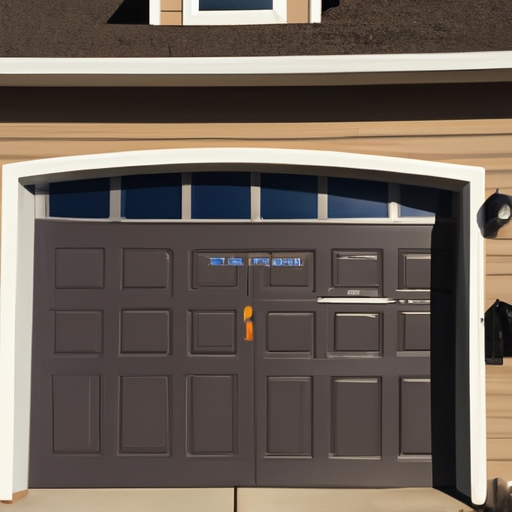Signs and symptoms of a broken garage door spring, including difficulty in opening or closing the door, loud noises, or uneven movement
When it comes to a broken garage door spring replacement, there are several signs and symptoms that one should be aware of. These indicators can help identify if the garage door spring is indeed broken. One of the most obvious signs is difficulty in opening or closing the door (duh!). If you find yourself struggling to operate your garage door, it could be due to a broken spring. Another telltale sign is loud noises (ouch!) coming from the garage door when you try to use it. These noises may indicate that the spring is damaged and needs to be replaced. Additionally, if you notice any uneven movement (yikes!) when opening or closing your garage door, it could be an indication of a broken spring.
Now, let's move on to how important it is to replace a broken garage door spring promptly. Neglecting this issue can lead to further damage, and even more expensive repairs down the line. When a garage door spring breaks, it puts extra strain on other components of the door system(like). This added stress can cause them to wear out faster and potentially break as well(nope). Moreover, attempting to operate a garage door with a broken spring can be dangerous(you betcha!). The unbalanced weight distribution can cause the door to become unstable and fall unexpectedly.
In order to avoid these potential risks and expenses(don't wanna deal with that!), replacing a broken garage door spring as soon as possible is crucial(shouldn't procrastinate!). Hiring a professional technician for this task is highly recommended(wouldn't want any mishaps!). These experts have the knowledge and experience necessary for safely removing the old broken springs and installing new ones(hallelujah!). They will also ensure that all other components are inspected and functioning properly.
In conclusion(to sum things up), recognizing the signs and symptoms of a broken garage door spring(Eureka!) is essential for prompt replacement. Difficulty in opening or closing the door, loud noises, and uneven movement are all indicators of a broken spring. Neglecting to replace a broken spring can lead to further damage and potential hazards. Hiring a professional technician is the best way to ensure a safe and effective garage door spring replacement. So don't wait(don't you dare!), take action if you suspect your garage door spring might be broken(you won't regret it!).
Importance of seeking professional help for broken garage door spring replacement due to safety risks involved and complexity of the task
Seeking professional help for broken garage door spring replacement is of utmost importance. The task itself is complex and requires specific knowledge (like) about the workings of garage doors. Moreover, attempting to replace a broken spring without proper training and equipment can pose serious safety risks (!). Therefore, it is crucial to engage the services of trained professionals who specialize in garage door repairs.
Firstly, the complexity of the task cannot be understated. Garage door springs are under high tension, making their replacement a potentially dangerous undertaking (+like). Without the necessary expertise, one may unknowingly mishandle the springs and cause them to snap back with great force (-like). This could result in severe injuries or property damage (oh no!). Thus, it is wise to leave this job to the experts who possess the skills and experience required.
Secondly, safety risks are inherent when dealing with broken garage door springs. These springs hold significant tension even when they break (+isn't). Attempting to replace them without proper precautions can lead to accidents that could have been easily avoided (-isn't). For instance, if a person fails to secure the spring properly while replacing it (-doesn't), it may suddenly release its tension and strike them with considerable force (ouch!). To prevent such unfortunate incidents from occurring (!), professional assistance is essential.
In addition to safety concerns, there are other reasons why seeking professional help for broken garage door spring replacement is vital. Professionals possess specialized tools and equipment designed specifically for this task (+didnt'). They also have access to high-quality replacement parts that may not be readily available to individuals attempting DIY repairs (-didnt'). By relying on experts who stay up-to-date with industry standards and best practices (+dont'), homeowners can ensure that their garage doors will be repaired efficiently and effectively.
To conclude, due to both safety risks involved (!) and the complexity of replacing broken garage door springs (+isn't), seeking professional help is crucial. With their knowledge, experience, and proper tools, professionals can ensure the task is completed safely and accurately (-isn't). So, when faced with a broken garage door spring (+isn't), it's always best to leave it to the experts who specialize in garage door repairs (+like).
Steps involved in broken garage door spring replacement process, including assessment of the type and size of the springs needed, removal of old springs, and installation of new ones
Broken garage door spring replacement is a task that requires careful attention to detail and (is not) something to be taken lightly. When a garage door spring breaks, it can cause the door to become inoperable and create potential safety hazards. Therefore, it is essential to follow the necessary steps involved in replacing the broken springs.
Firstly, (let's start off) with assessing the type and size of the springs needed for your garage door. This step involves examining the current springs and determining their specifications. It is crucial to identify whether you have torsion or extension springs, as well as their specific dimensions. Failure to select the right type and size of springs could result in further damage to your garage door system!
After completing the assessment phase, it's time to proceed with removing the old springs. This step can be quite challenging and (ain't) recommended for inexperienced individuals. You'll need appropriate tools such as winding bars and safety glasses before attempting this task. Careful attention should be given while detaching the broken springs from their brackets or cones.
Once the old springs are successfully removed, it's time for installation of new ones! Begin by attaching one end of each spring onto its respective bracket or cone using proper fasteners. Then, carefully wind up the springs using winding bars while ensuring they are properly tensioned. Improper tensioning can lead to an unbalanced garage door that may not operate smoothly.
In conclusion, replacing broken garage door springs involves several critical steps: assessing the type and size of needed springs, removing old ones cautiously, and installing new ones correctly (you know). Each step demands attention to detail and proper use of tools! Neglecting any of these steps or making mistakes during this process could lead to further damages or even accidents occurring.
In summary,(to sum up) broken garage door spring replacement is no easy feat! It requires ample knowledge about spring types and sizes along with careful removal and installation techniques. So, if you're facing a broken garage door spring situation, it's advisable to seek professional assistance to ensure the job is done safely and efficiently.
Discussion on different types of garage door springs available in the market, such as torsion springs and extension springs, and their pros and cons
When it comes to broken garage door spring replacement, there are various types of springs available in the market, including torsion springs and extension springs. Each type has its own advantages and disadvantages, making it essential to understand their differences before making a decision (well, duh!).
Torsion springs are commonly used for heavy-duty doors due to their ability to provide more balance and stability. They work by twisting (or coiling) tightly when the door is closed and then releasing that tension when the door is opened. This mechanism allows for smoother operation and less strain on the opener (no way!).
On the other hand, extension springs are often found in lighter garage doors. These springs stretch out as the door closes and contract back when it opens. While they may not have the same durability as torsion springs, they offer a more cost-effective solution (yippee!) for those with smaller or less frequently used garages.
One advantage of torsion springs is that they generally last longer than extension springs. Their design distributes weight evenly across multiple coils, reducing wear and tear on individual parts (seriously?). Additionally, torsion springs tend to be safer because they are mounted above the door rather than along its sides like extension springs.
However, one downside of torsion springs is that they can be more challenging to install or replace compared to extension springs. Due to their positioning above the door, professional assistance may be required for proper installation or maintenance (oh no!). Moreover, torsion spring systems can be pricier upfront compared to their counterparts.
In contrast, while extension spring systems may seem easier to handle due to their side-mounted position (easy peasy!), they carry a higher risk of accidents if not properly maintained or replaced. The exposed nature of these springs makes them susceptible to snapping or detaching unexpectedly (yikes!). Therefore, regular inspection and maintenance are crucial for ensuring safety.
In conclusion (!), understanding the different types of garage door springs available in the market is essential when it comes to broken garage door spring replacement. While torsion springs offer better durability and safety, extension springs can be a more cost-effective option for lighter doors. However, professional assistance should always be sought to ensure proper installation and maintenance regardless of the chosen type (all in all!).
Tips for maintaining garage door springs to prevent premature wear and breakage, such as regular lubrication and inspection for signs of damage
When it comes to broken garage door spring replacement, there are several tips that can help prevent premature wear and breakage. One of the most important things to do is regular lubrication (like greasing) of the springs. This helps reduce friction between the coils and prolongs their lifespan! Another crucial tip is inspecting for signs of damage (such as cracks or rust) on a frequent basis.
To ensure safety, it's essential to avoid attempting DIY repairs on garage door springs. These components are under high tension and mishandling them could result in severe injuries! Instead, it is highly recommended to hire a professional technician who specializes in broken garage door spring replacement. They have the expertise and proper tools needed to handle the task safely (or risk-free).
Regular maintenance of your garage door springs can also help prevent premature wear and breakage. This includes cleaning them regularly (to remove dirt or debris) and tightening any loose bolts or screws. Additionally, keep an eye out for any unusual noises or movements when operating your garage door as these may indicate a problem with the springs.
In conclusion, taking care of your garage door springs is vital to prevent premature wear and breakage. Regular lubrication, inspection for damage, and hiring a professional for replacement are key steps towards maintaining their longevity (or long-lastingness). Remember to avoid attempting repairs yourself as this can be extremely dangerous (!), always prioritize safety first when dealing with these components.
In summary, by following these tips (or pieces of advice), you can ensure that your garage door springs remain in good condition for a longer period of time, saving you from unexpected expenses or inconvenience caused by a broken spring.
Common mistakes to avoid during broken garage door spring replacement, such as attempting DIY repairs without proper knowledge or tools
When it comes to broken garage door spring replacement, there are common mistakes that people should avoid (like really, seriously). One of the most common mistakes is attempting to do DIY repairs without having the proper knowledge or tools. (Ugh!) This can lead to further damage and even potential harm! (Oh no!)
Doing a garage door spring replacement without the right knowledge can be quite tricky. It's important to understand how the springs function and what precautions need to be taken. (By the way), these springs are under high tension and if not handled correctly, they can cause serious injury. So, it's best to leave this task to professionals who have experience in dealing with such situations.
Another mistake that many people make during broken garage door spring replacement is neglecting safety measures. People often overlook wearing protective gear like gloves or goggles, which puts them at risk for accidents or injuries. (I mean seriously, who does that?) Safety should always come first when working with heavy machinery or repairing garage doors.
Moreover, using improper tools for broken garage door spring replacement can lead to disastrous consequences. Many individuals try using random household tools instead of specialized equipment designed for this purpose. This not only increases the chances of damaging the springs but also compromises their overall functionality.(Like really now?)
In conclusion,(by all means) attempting DIY repairs for broken garage door spring replacement without proper knowledge or tools is a big no-no! It's essential to seek professional help as they possess the expertise and equipment required for safe and effective repairs.(You got it!) Remember, your safety should never be compromised when dealing with complex home repairs like this one.

